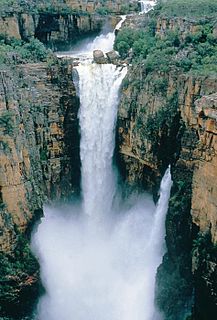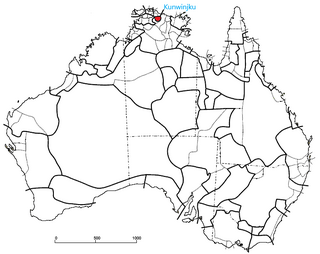Related Research Articles

The wandering whistling duck is a species of whistling duck. They inhabit tropical and subtropical Australia, the Philippines, Borneo, Indonesia, Papua New Guinea and the Pacific Islands.
Iwaidja, in phonemic spelling Iwaja, is an Australian aboriginal language of the Iwaidja people with about 123 native, with an extra 20 to 30 L2 speakers in northernmost Australia. Historically having come from the base of the Cobourg Peninsula, it is now spoken on Croker Island. It is still being learnt by children within the Northern Territory.

Gunbalanya is an Aboriginal Australian town in west Arnhem Land in the Northern Territory of Australia, about 300 kilometres (190 mi) east of Darwin. The main language spoken in the community is Kunwinjku. At the 2021 Australian census, Gunbalanya had a population of 1,177.
Bininj Kunwok is an Australian Aboriginal language which includes six dialects: Kunwinjku, Kuninjku, Kundjeyhmi, Manyallaluk Mayali (Mayali), Kundedjnjenghmi, and two varieties of Kune. Kunwinjku is the dominant dialect, and also sometimes used to refer to the group. The spellings Bininj Gun-wok and Bininj Kun-Wok have also been used in the past, however Bininj Kunwok is the current standard orthography.
Allosyncarpia ternata, commonly known as an-binik, is a species of rainforest trees constituting part of the botanical family Myrtaceae and included in the eucalypts group. The only species in its genus, it was described in 1981 by Stanley Blake of the Queensland Herbarium. They grow naturally into large, spreading, shady trees, and are endemic to the Northern Territory of Australia. They grow in sandstone gorges along creeks emerging from the Arnhem Land plateau.
Nicholas "Nick" Evans is an Australian linguist and a leading expert on endangered languages. He was born in Los Angeles, USA.

The Jim Jim Falls is a plunge waterfall on the Jim Jim Creek that descends over the Arnhem Land escarpment within the UNESCO World Heritage–listed Kakadu National Park in the Northern Territory of Australia. The Jim Jim Falls area is registered on the Australian National Heritage List.

The Kunwinjku people are an Australian Aboriginal people, one of several groups within the Bininj people, who live around West Arnhem Land to the east of Darwin, Northern Territory. Kunwinjku people generally refer to themselves as "Bininj" in much the same way that Yolŋu people refer to themselves as "Yolŋu".
Maung is an Australian aboriginal language spoken by the Maung people on the Goulburn Islands, off the north coast of Arnhem Land, in the Northern Territory of Australia. Maung is closely related to Iwaidja language which occupies the northwestern corner of the opposite mainland. This is a language that belongs to the Iwaidjan language family of Non-Pama–Nyungan languages. As of 2016, there were 370 speakers of the language.
Gunbarlang, or Kunbarlang, is an Australian Aboriginal language in northern Australia with multiple dialects. Other names are Gungalang and Warlang. Speakers are multilingual in Kunwinjku and Mawng. Most of the Gunbarlang people now speak Kunwinjku.
Kune is a dialect of Bininj Kunwok, an Australian Aboriginal language. The Aboriginal people who speak Kune are the Bininj people, who live primarily in western Arnhem Land. Kune is spoken primarily in the south-east of the Bininj Kunwok speaking areas, particularly in the Cadell River district south of Maningrida. This includes outstations such as Korlobidahdah, Buluhkaduru and Bolkdjam. Grammatically Kune is closely related to other varieties of Bininj Kunwok, however there are many differences in vocabulary.
Rembarrnga (Rembarunga) is an Australian Aboriginal language. It is one of the Northern Non-Pama–Nyungan languages, spoken in the Roper River region of the Northern territory. There are three dialects of Rembarrnga, namely Galduyh, Gikkik and Mappurn. It is a highly endangered language, with very few remaining fluent speakers. It is very likely that the language is no longer being learned by children. Instead, the children of Rembarrnga speakers are now learning neighbouring languages such as Kriol in south central Arnhem Land, and Kunwinjku, a dialect of Bininj Kunwok, in north central Arnhem Land.
Kunwinjku is a dialect of Bininj Kunwok, an Australian Aboriginal language. The Aboriginal people who speak Kunwinjku are the Bininj people, who live primarily in western Arnhem Land. As Kunwinjku is the most widely spoken dialect of Bininj Kunwok, 'Kunwinjku' is sometimes used to refer to Bininj Kunwok as a whole. Kunwinjku is spoken primarily in the west of the Bininj Kunwok speaking areas, including the town of Gunbalanya, as well as outstations such as Mamardawerre, Kumarrirnbang, Kudjekbinj and Manmoyi.
The Maung people, or Warruwi, are an Aboriginal Australian people living on the Goulburn Islands, in the Arafura sea off the coast of the Northern Territory.
The Bininj are an Aboriginal Australian people of Western Arnhem land in the Northern Territory. The sub-groups of Bininj are sometimes referred to by the various language dialects spoken in the region, that is, the group of dialects known as Bininj Kunwok; so the people may be named the Kunwinjku, Kuninjku, Kundjeyhmi (Gundjeihmi), Manyallaluk Mayali, Kundedjnjenghmi and Kune groups.
Calytrix achaeta, commonly known as the white-flowered turkey bush, kerosene wood or fringe-myrtle, is a species of plant in the myrtle family Myrtaceae that is native to Western Australia and the Northern Territory.
The Gaagudju, also known as the Kakadu, are an Aboriginal Australian people of the Northern Territory. There are four clans, being the Bunitj or Bunidj, the Djindibi, and two Mirarr clans. Three languages are spoken among the Mirarr or Mirrar clan: the majority speak Kundjeyhmi, while others speak Gaagudju and others another language.
Kuninjku is a dialect of Bininj Kunwok, an Australian Aboriginal language. The Aboriginal people who speak Kuninjku are the Bininj people, who live primarily in western Arnhem Land. Kunwinjku is spoken primarily in the east of the Bininj Kunwok speaking areas, particularly the outstations of Maningrida such as Mumeka, Marrkolidjban, Mankorlod, Barrihdjowkkeng, Kakodbebuldi, Kurrurldul and Yikarrakkal.
Mayali or Manyallaluk Mayali is a dialect of Bininj Kunwok, an Australian Aboriginal language. The Aboriginal people who speak Mayali are the Bininj people, who live primarily in western Arnhem Land. Mayali is spoken primarily in south-west Arnhem Land, particularly around Pine Creek, Katherine and Manyallaluk. Occasionally the term "Mayali" is used to refer to all Bininj Kunwok dialects collectively, however this is not generally accepted usage. Speakers of the Kundjeyhmi dialect of Bininj Kunwok often regard Mayali as similar to, or even the same as, Kundjeyhmi.
Kundedjnjenghmi is a dialect of Bininj Kunwok, an Australian Aboriginal language. The Kundedjnjenghmi dialect is native to the high 'stone country' of the Arnhem Plateau. Younger speakers in this area have largely switched to other varieties of Bininj Kunwok, although they retain a passive knowledge of Kundedjnjenghmi. A number of songs by the Nabarlek band use the Kundedjnjenghmi dialect, as do traditional 'Kunborrk' songs.
References
- ↑ "SBS Australian Census Explorer" . Retrieved 12 October 2022.
- ↑ n71 Kundjeyhmi at the Australian Indigenous Languages Database, Australian Institute of Aboriginal and Torres Strait Islander Studies
- 1 2 "Orthography— how to write words". Bininj Gunwok. Kunwinjku Language Project. Retrieved 1 October 2015.
- 1 2 3 "Dialects". Bininj Kunwok: Kunwok dja mankarre kadberre—our language, our culture. Bininj Kunwok Regional Language Centre. Retrieved 12 October 2022.